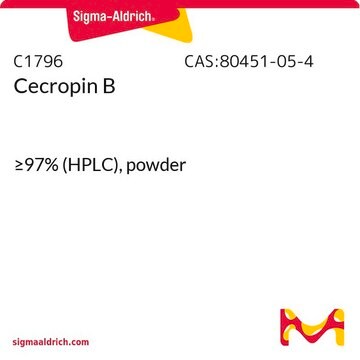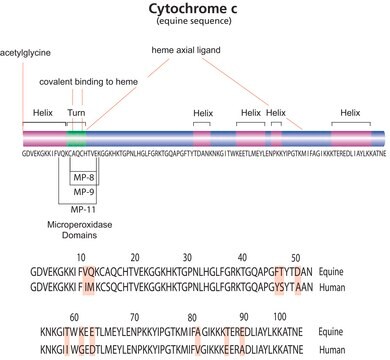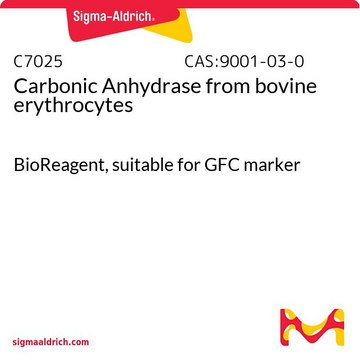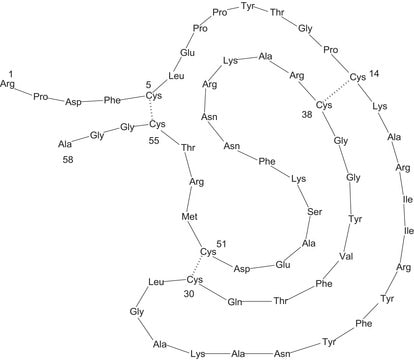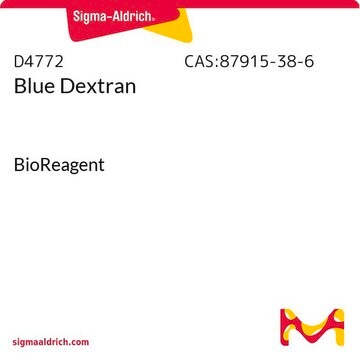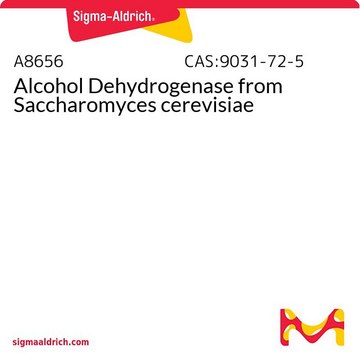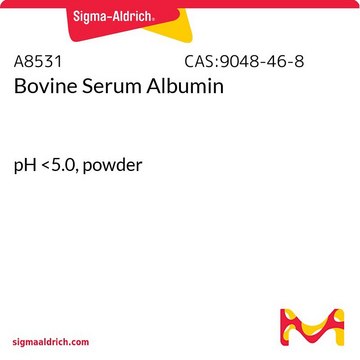C7150
Citocromo c from equine heart
suitable for GFC marker, BioReagent
Sinónimos:
Citocromo c from horse heart
Iniciar sesiónpara Ver la Fijación de precios por contrato y de la organización
About This Item
Productos recomendados
product line
BioReagent
Quality Level
form
powder
mol wt
~12,400
packaging
vial of ≥10 mg
suitability
suitable for GFC marker
storage temp.
−20°C
¿Está buscando productos similares? Visita Guía de comparación de productos
Application
Se caracterizaron los sitios específicos y el grado de oxidación en el citocromo c caballo tratado con H2O2 y UV. Se sugirió que el estado de estos sitios podría utilizarse como biomarcador del entorno oxidativo de una célula.
Cytochrome c is primarily known as an electron-carrying mitochondrial protein and is generally regarded as a universal catalyst of respiration. Cytochrome c can be used as a gel filtration molecular weight marker in gel filtration chromatography and protein chromatography and can be used to study cytochrome c control proteins, electron transport and cellular respiration.
Biochem/physiol Actions
El citocromo c se conoce fundamentalmente como una proteína mitocondrial transportadora de electrones. La transición del citocromo c entre los estados ferroso y férrico dentro de la célula la convierte en un eficiente transportador biológico de electrones y desempeña un papel vital en las oxidaciones celulares tanto en plantas como en animales. Se considera generalmente como un catalizador universal de la respiración, formando un puente de electrones esencial entre los sustratos respirables y el oxígeno
Other Notes
Encontrará más información sobre el citocromo c y el transporte de electrones en www.sigma-aldrich.com/enzymeexplorer.
Storage Class
11 - Combustible Solids
wgk_germany
WGK 3
flash_point_f
Not applicable
flash_point_c
Not applicable
ppe
Eyeshields, Gloves, type N95 (US)
Elija entre una de las versiones más recientes:
¿Ya tiene este producto?
Encuentre la documentación para los productos que ha comprado recientemente en la Biblioteca de documentos.
Los clientes también vieron
Federica Sinibaldi et al.
Journal of inorganic biochemistry, 105(11), 1365-1372 (2011-09-29)
In cells a portion of cytochrome c (cyt c) (15-20%) is tightly bound to cardiolipin (CL), one of the phospholipids constituting the mitochondrial membrane. The CL-bound protein, which has nonnative tertiary structure, altered heme pocket, and disrupted Fe(III)-M80 axial bond
Paolo Ascenzi et al.
Biochemical and biophysical research communications, 415(3), 463-467 (2011-11-08)
Carboxymethylation of equine heart cytochrome c (cytc) changes its tertiary structure by disrupting the heme-Fe-Met80 distal bond, such that carboxymethylated cytc (CM-cytc) displays myoglobin-like properties. Here, the effect of cardiolipin (CL) on peroxynitrite isomerization by ferric CM-cytc (CM-cytc-Fe(III)) is reported.
Kelly Watters et al.
PLoS pathogens, 14(12), e1007477-e1007477 (2018-12-12)
Viruses in the rhinovirus C species (RV-C) are more likely to cause severe wheezing illnesses and asthma exacerbations in children than related isolates of the RV-A or RV-B. The RV-C capsid is structurally distinct from other rhinoviruses and does not
Eva Di Silvio et al.
Biochimica et biophysica acta, 1834(8), 1554-1561 (2013-05-08)
The biogenesis of c-type cytochromes (Cytc) is a process that in Gram-negative bacteria demands the coordinated action of different periplasmic proteins (CcmA-I), whose specific roles are still being investigated. Activities of Ccm proteins span from the chaperoning of heme b
Esther Lapuente-Brun et al.
Science (New York, N.Y.), 340(6140), 1567-1570 (2013-07-03)
The textbook description of mitochondrial respiratory complexes (RCs) views them as free-moving entities linked by the mobile carriers coenzyme Q (CoQ) and cytochrome c (cyt c). This model (known as the fluid model) is challenged by the proposal that all
Protocolos
Gel filtration chromatography is an established method for determining the size and molecular mass of proteins.
Chromatograms
application for HPLCapplication for HPLCapplication for HPLCNuestro equipo de científicos tiene experiencia en todas las áreas de investigación: Ciencias de la vida, Ciencia de los materiales, Síntesis química, Cromatografía, Analítica y muchas otras.
Póngase en contacto con el Servicio técnico